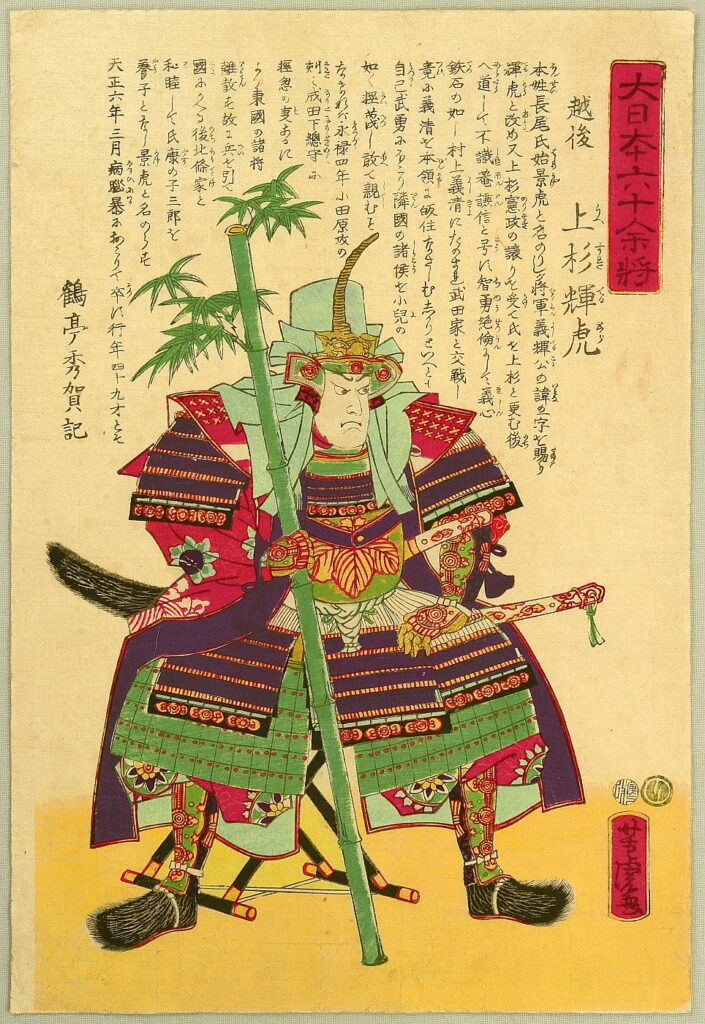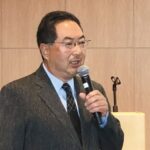

上杉謙信 UESUGI Kenshin
1530 – 1578
“The Dragon of Echigo”
Uesugi Kenshin (上杉謙信) was a powerful warlord, a brilliant strategist, and a wise administrator. He was born on February 18, 1530 at Kasugayama in Echigo province as the fourth son of the noted warrior Nagao Tamekage (長尾為景), who was also a powerful warlord. Kenshin is famous for being known as the biggest rival of Takeda Shingen and have fought five times with him at the battle of Kawanakajima. Because a dragon was painted on his flag which was carried at the battle, he was called “the dragon of Echigo”.
Early Life
Kenshin’s childhood name was Torachiyo (Tora means tiger) because he was born in the year of tiger in the Chinese zodiac. His father, Nagao Tamekage from the Nagao clan, was a great warlord due to his victories over Uesugi Sadanori and Uesugi Funayoshi. However, Tamekage soon started a conflict with his neighbors and the situation for Echigo quickly deteriorated until Tamekage gathered up an army in 1536 and marched westward. However, upon arriving in Ecchu, his forces were attacked. In August, his older brother Harukage inherited the Nagao family. In December, Tamekage died because of illness. On the same year, Torachiyo was sent to a temple and started to learn Buddhism, administration, and martial arts.
In 1543, he celebrated his coming of age and changed his name to Kagetora. He moved to Nagaoka and became a lord of Tochio castle. In the following year, his neighbors attacked him, but Kagetora won this first ever fight for him with help by the Honjo family, the Yamayoshi family, and the Nagao family. Kagetora was only 14 years old. October in 1545, Kagetora’s brother Kageyasu was killed by a servant of the Uesugi clan, Kuroda Hidetada, who caused revolt again in the next year. So Kagetora defeated him and ruined the Kuroda family.
Career
Kagetora has continued to win battles.
His brother Harukage and cousin Nagao Masakage were afraid that Kagetora would overcome their power someday, so they attacked Kagetora in his castle. However, Kagetora had noticed it in advance, and was already ready to intercept. He won a series of engagements against Harukage’s supporters that led to Kagetora’s victory in 1547. Kagetora inherited the Nagao family, a deputy of provincial governor of Echigo, and came back to Kasugayama castle where he was born.
In 1550, Shogun Ashikaga Yoshiteru gave him the position as a governor-general. Kagetora defeat Nagao Masakage’s rebellion in the following year. Kagetora had then received a visitor, Uesugi Norimasa, his nominal overlord and the head of the Yamanouchi branch of the Uesugi, who had suffered with the Hojo family’s advances in the Kanto region. Losing Hirai Castle in Kozuke, Norimasa was seeking refuge in Echigo so Kagetora sheltered him. Two years later, at the request of Shinano, Kagetora faced Takeda Shingen at the first battle of Kawanakajima to try to stop Takeda’s forces, and sent his troops to Kita Shinano.
In September of 1553, Kagetora travelled to Kyoto for the first time and met the Emperor Go-Nara and the Shogun Ashikaga Yoshiteru. The rebellion of Kitajo Takahiro happened then, and the second battle of Kawanakajima sparked in 1555 which hasn’t been settled. The territorial disputes of his servants made him so tired that he declared to become a priest and left Echigo, but was later persuaded by Nagao Masakage to return to Echigo. He then unified Echigo province after defeating Okuma Tomohide who revolted.
In 1557, he fought with Takeda Shingen at the third battle of Kawanakajima because Shingen had advanced invading Shinano.
In 1559, he went to Kyoto again to visit the Emperor and Shogun, then returned to Echigo in November. He took the field in 1560 into the Kanto region. In the next year, he pushed further into the Hojo domain by capturing many castles of the Hojo clan, such as Furukawa Gosho and Odawara Castle, broke through Hojo’s defenses, and burnt Odawara Town. He then visited the Tsurugaoka Hachiman Shrine and announced the adoption of both the name Uesugi and changed his first name to Masatora.
In August, Masatora and Shingen who have been sworn rivals for more than 14 years, fought their greatest battle — the fourth battle of Kawanakajima. Masatora hired and brought 18,000 soldiers, Shingen 20,000. The result of this battle is actually uncertain, but there are few certain facts: Both lost numerous soldiers. Masatora lost more than 3,000, Shingen himself got injured and lost more than 4,000 including his brother Nobushige and his advisor Yamamoto Kansuke. It’s also said that Masatora may nearly have defeated Shingen.
Masatora changed his name again, to Terutora. He captured Oyama Castle in 1563, and Oda Castle in the following year. The fifth battle of Kawanakajima was in 1564. Shingen attacked Hida, and Terutora wanted to interrupt this. He tried to beat up Shingen in a short term battle but couldn’t because Shingen avoided to fight with Terutora directly. Both parties didn’t clash and their long term battle finally ended. In 1568, Shogun gave him the title as Kanto Kanrei, a shogunal deputy for the Kanto region. Uesugi clan reconciliated with Hojo Ujiyasu and adopted the seventh son of Ujiyasu, Hojo Saburo, who was given good care and a new name, Kagetora. Terutora himself changed his name again, and named himself Uesugi Kenshin in 1571, when he was 41 years old.
His fighting life had continued. In 1571, after the death of Hojo Ujiyasu, Hojo Ujimasa broke the alliance with Kenshin and allied with Shingen. Kenshin faced then Takeda/Hojo allied forces at the Tonegawa river. Shingen started to invade the Western and allied with Oda Nobunaga, but he suddenly died in March 1573. Then, Kenshin brought Ecchu country under control completely. He then allied with the Takeda/Hojo and joined the anti-Nobunaga forces. In 1577, he led 20,000 soldiers and won the battle of Tedorigawa against Oda power which had a huge troop with 40,000 soldiers. In December, he returned to Kasugayama Castle and started to prepare for expedition to the Kanto region in March. But all of a sudden, he collapsed in the bathroom in the castle and passed away. It is said that the cause of his death might have been a stroke.
Others
Kenshin is well known as a strategist and tactician who have fought 70 battles in his whole life and lost only two times. His flag was designed with a character of “毘” which was taken from “毘沙門天” (Bishamonten, “Vaiśravaṇa” in Sanskrit which is a Buddha of the Tenbu, deities who reside in a heavenly realm, this being one of six realms in which the souls of living beings transmigrate from one to another, in Buddhism), because Kenshin believed that he is a rebirth of Bishamon, the god of war. He was also a competent civil administrator and contributed in increasing the economic power in Echigo. He encouraged Echigo’s lucrative hemp trade, built the Kasugayama Castle, and revitalized the seaport of Kashiwazaki. He also offered merchants tax incentives so that they create business in Echigo. He never married during his life and his children were all adopted.
.
.
.




